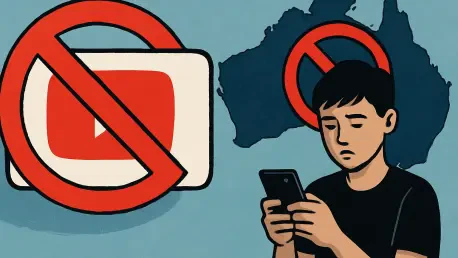In a groundbreaking move that has sent ripples through the digital landscape, Australia has extended its stringent social media regulations to include a ban on YouTube for users under the age of 16, marking one of the most significant steps yet in the nation’s ongoing crusade to safeguard young people from the potential dangers of online platforms. This decision, rooted in mounting concerns over mental health, online safety, and invasive data practices, positions Australia at the forefront of a global debate about how to protect minors in an era where digital spaces dominate daily life. YouTube, a platform synonymous with entertainment, education, and social connection for millions worldwide, now finds itself at the center of a policy that challenges the unchecked influence of tech giants. The ban raises profound questions about balancing child protection with access to valuable digital resources, while also spotlighting the pervasive tracking mechanisms that underpin much of the internet’s business model. As this policy unfolds, it touches on issues far beyond a mere age restriction, impacting families, educators, content creators, and the tech industry at large. This article delves into the motivations behind the ban, its alignment with international trends, the privacy concerns driving it, and the myriad challenges and consequences that lie ahead for all stakeholders involved.
Unpacking the Rationale Behind the Restriction
The driving force behind Australia’s decision to restrict YouTube access for those under 16 lies in a deep-seated concern for the well-being of young internet users navigating an often unregulated digital world. Policymakers have cited a range of risks, from exposure to harmful or age-inappropriate content to the pervasive threat of cyberbullying that can thrive on platforms with vast, unmoderated user bases. Additionally, the mental health implications of prolonged engagement with social media and video-sharing sites have come under intense scrutiny, with studies linking excessive screen time to heightened anxiety, depression, and diminished self-esteem among teenagers. YouTube’s algorithm, designed to maximize user retention by recommending increasingly engaging content, can sometimes lead vulnerable viewers down rabbit holes of extreme or addictive material, amplifying these concerns. The Australian government views this ban as a necessary intervention to shield minors from such psychological pressures before they develop the maturity to handle them.
Beyond the visible content-related dangers, there’s a less obvious but equally pressing issue fueling this policy: the role of YouTube as a data collection powerhouse. Owned by Google, the platform employs sophisticated tracking tools to monitor user interactions, from video preferences to search histories, often without transparent consent from younger users who may not fully comprehend the implications. This data is then used to tailor advertisements and content, creating personalized experiences that can border on manipulative for impressionable minds. The ban represents an attempt to disrupt this cycle of surveillance and influence, prioritizing child safety over the commercial interests of tech giants. By including YouTube in the broader social media crackdown, Australia underscores that even platforms perceived as less “social” than others are not exempt from responsibility when it comes to protecting the youngest demographics.
Aligning with Worldwide Digital Oversight Efforts
Australia’s bold step to limit YouTube access for minors does not stand in isolation but mirrors a growing international movement to impose stricter controls on digital platforms, particularly where children are concerned. The European Union, through its General Data Protection Regulation (GDPR), has set a high bar for how companies must handle personal data, with specific provisions to protect younger users by requiring clear consent and limiting data processing. Similarly, in the United States, ongoing conversations about enhancing the Children’s Online Privacy Protection Act (COPPA) reflect a shared recognition that tech companies must be held accountable for the online environments they create. These global initiatives converge on a central idethe digital realm requires governance akin to physical spaces, especially to safeguard vulnerable populations from exploitation and harm.
While many nations are wrestling with similar issues, Australia’s approach stands out for its decisiveness in targeting a platform as ubiquitous as YouTube. This move aligns with a broader consensus that unrestricted access to digital content can pose more risks than benefits for those under 16, yet it also contrasts with alternative strategies seen elsewhere. Some countries advocate for bolstering digital literacy programs to equip young users with the skills to navigate online spaces safely, rather than imposing outright bans. This divergence in tactics highlights a critical debate within the global community about the most effective way to balance protection with empowerment. Australia’s hardline policy, while protective in intent, positions it as a test case for whether such restrictions can achieve their goals without unintended consequences, offering valuable lessons for other regions observing from afar.
Privacy at the Core: Data Tracking on Digital Platforms
A pivotal concern propelling Australia’s ban on YouTube for under-16s is the extensive data collection practices that underpin the platform’s operations, often operating out of sight for the average user. YouTube utilizes a complex array of cookies and tracking mechanisms to log every interaction—be it a video watched, a search conducted, or a comment posted—building detailed profiles that inform both content recommendations and targeted advertising. For minors, who may lack the awareness or agency to understand how their online behavior is being monetized, this constant surveillance raises significant ethical dilemmas. The risk isn’t just theoretical; tailored content can subtly shape viewing habits, sometimes pushing young users toward material that prioritizes engagement over their well-being.
Privacy advocates have long argued that such data practices exploit vulnerable groups, turning personal preferences into commodities without meaningful consent. The Australian government’s decision to include YouTube in its social media crackdown indirectly challenges this business model, aiming to insulate children from becoming data points in a vast advertising ecosystem before they can make informed decisions about their digital footprint. This aspect of the policy underscores a broader tension between technological innovation and individual rights, particularly for those least equipped to navigate it. By limiting access, regulators hope to mitigate the risks of behavioral manipulation and privacy invasion, though the effectiveness of this approach remains to be seen against the backdrop of an internet built on data-driven revenue.
Navigating the Hurdles of Policy Implementation
Enforcing a ban on YouTube for users under 16 presents a labyrinth of practical challenges that could undermine its intended impact if not carefully addressed. A primary obstacle is the issue of age verification—determining a user’s eligibility to access the platform without infringing on privacy further is a delicate balancing act. Requiring personal information to confirm age, such as identification documents or credit card details, risks creating new vulnerabilities, as this data could be mishandled or exploited. Previous attempts at age-gating on other digital services have often faltered, with young users bypassing restrictions by providing false information or accessing accounts through older family members, casting doubt on the feasibility of a watertight ban.
Compounding the enforcement dilemma is the stance of tech giants like Google, which operates YouTube and stands to lose significant engagement and advertising revenue from younger demographics. Historically, large technology firms have resisted regulations that threaten their user base or profitability, as seen in past disputes over data privacy laws in various regions. Whether Google will fully cooperate with Australia’s mandate or challenge it through legal or technical means remains an open question, one that could delay or dilute the policy’s rollout. Additionally, the ban’s scope raises logistical concerns, particularly around educational use. YouTube serves as a vital tool in many classrooms, offering free access to instructional content. Deciding whether to grant exceptions for academic purposes, and how to administer them, adds another layer of complexity to an already intricate enforcement landscape.
Consequences for Young Users and Their Families
The ramifications of restricting YouTube access for those under 16 extend deeply into the lives of young users and their households, reshaping how they engage with the digital world. For many teenagers and preteens, YouTube is far more than a source of entertainment—it’s a treasure trove of educational resources, offering tutorials on subjects ranging from science to creative arts at no cost. Losing access to such content could hinder learning opportunities, particularly for students in under-resourced communities who rely on free online materials to supplement formal education. This policy might inadvertently widen existing gaps in access to knowledge, leaving some young users at a disadvantage compared to their peers in less restrictive regions.
For families, the ban presents a mixed bag of challenges and potential relief. Parents in lower-income brackets, who often depend on platforms like YouTube to provide affordable entertainment or learning tools for their children, may struggle to find suitable alternatives that match the platform’s breadth and accessibility. Conversely, some caregivers might embrace the restriction as a means to reduce screen time and limit exposure to potentially harmful content, easing the constant need to monitor online activity. However, this does not eliminate the broader responsibility to guide children through the digital landscape, as the ban could push curious young users toward other, less regulated platforms. The shift in how kids connect socially is another concern—YouTube often serves as a shared cultural touchpoint for peer interactions, and its absence might alter social dynamics or drive teens to seek connection in riskier online spaces.
Economic and Industry-Wide Repercussions
The economic fallout from Australia’s YouTube ban for under-16s reverberates through the digital content creation sphere and the broader tech industry, posing immediate challenges for those who depend on the platform for their livelihood. Content creators, especially those producing material tailored for younger audiences—such as family-friendly vlogs, educational videos, or gaming streams—stand to lose a substantial portion of their viewership overnight. This drop in engagement directly impacts advertising revenue, which forms the backbone of income for many YouTubers, potentially forcing some to pivot their content or seek alternative platforms with less reach or monetization potential. The ripple effect could reshape the creator economy, particularly for smaller channels that lack the resources to adapt quickly.
On a larger scale, the tech industry, led by Google as YouTube’s parent company, faces significant financial implications from this policy. Younger users contribute heavily to the platform’s overall engagement metrics, which in turn drive advertising dollars—a key revenue stream. While Google might mitigate losses by promoting child-specific alternatives like YouTube Kids, a restricted version with curated content, the overall impact on user numbers could still sting. Beyond immediate economics, Australia’s move sets a precedent that other nations might follow, prompting tech giants to reassess how they target and monetize younger demographics. This could lead to innovation in safer digital spaces or, conversely, heightened resistance to regulatory overreach, as Silicon Valley watches closely to gauge the global implications of such a restrictive measure.
Broader Societal and Cultural Implications
The decision to ban YouTube for users under 16 in Australia compels a deeper examination of technology’s role in shaping the experiences and development of younger generations, extending far beyond immediate policy effects. YouTube is not merely a digital platform; it functions as a cultural cornerstone where kids and teens learn new skills, express creativity, and build communities around shared interests. Restricting access to this space prompts critical reflection on what society prioritizes in the digital upbringing of its youth—protection from online harms versus the freedom to explore and connect in virtual environments. This policy leans heavily toward safeguarding, but it also risks severing a vital link to global culture and knowledge for many young people.
Ethically, the ban illuminates a fundamental clash between state intervention and individual autonomy in the digital realm. Should governments act as gatekeepers, shielding minors from the internet’s pitfalls, or should the onus fall on families and educational systems to foster resilience and critical thinking in online spaces? Australia’s stance favors the former, yet this perspective is not universally shared, as some argue that outright restrictions fail to address underlying issues like the lack of comprehensive digital education. The ban also highlights the urgent need for robust digital literacy initiatives to complement regulatory measures. Teaching young users to navigate technology responsibly, understand data privacy, and discern credible content is essential, as no policy can fully insulate them from the complexities of the online world. This restriction may have sparked a necessary debate, but it remains only a fragment of the broader solution needed to ensure a safe and enriching digital future.
Reflecting on the Path Forward
Looking back, Australia’s implementation of a YouTube ban for those under 16 emerged as a pivotal moment in the nation’s approach to digital regulation, driven by a commitment to shield young users from mental health risks, harmful content, and invasive data practices. This policy, while rooted in protective intent, navigated a complex terrain of enforcement challenges, from age verification hurdles to resistance from tech giants, revealing the intricate balance required to enact such sweeping restrictions. Its impact rippled through families, educators, and the content creation economy, exposing both the potential benefits of reduced online exposure and the unintended loss of valuable resources for learning and connection.
Moving ahead, the focus should shift toward sustainable solutions that address the root causes of digital harms without sacrificing access to beneficial content. Developing robust digital literacy programs stands out as a critical next step, equipping young users with the tools to critically engage with online platforms while fostering informed decision-making. Additionally, collaboration between governments, tech companies, and educational institutions could pave the way for curated, safe digital spaces that cater specifically to minors, offering a middle ground between outright bans and unrestricted access. International dialogue will also be key, as Australia’s experience provides a blueprint—and a cautionary tale—for other nations grappling with similar issues. Ultimately, the path forward demands a nuanced strategy that prioritizes both protection and empowerment, ensuring the digital world becomes a space of opportunity rather than risk for the next generation.









